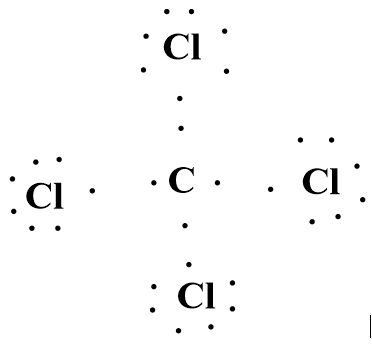
When two pairs of electrons are shared, bond is.
(a) Single covalent bond
(b) Double covalent bond
(c) Dative bond
(d) Triple bond
Answer
221.7k+ views
Hint: The mutual sharing of electrons between the participating atoms leads to the formation of a covalent bond. The electron pair which involves in the formation of a covalent bond is called a shared pair and bonding pair electrons. During the covalent bond formation, the sharing of electrons occurs to achieve the noble gas electronic configuration.
Complete step by step solution:A covalent bond is formed between the atom of the same elements (\[{H_2},C{l_2}\]and \[{O_2}\])or between the atom of two different elements having almost same electronegativity difference (\[{H_2}O,C{H_4}\]and \[N{H_3}\]).
Atoms share their electron pair to achieve inert noble gas electronic configuration or to gain stability.
The following is the Lewis Dot Structure of the \[CC{l_4}\]molecule, showing the covalent bond formation by sharing electrons between chlorine and a carbon atom. The Lewis Dot Structure also represents that each atom is following the octet rule.

Image: Lewis Dot Structure of the \[CC{l_4}\]molecule.
The covalent bond can be divided into three types based on the sharing of electron pairs.
(1) Single bond: Formed when sharing of only one electron takes place between two atoms.
For e.g., \[HCl\]has a single bond formed by the sharing of a single electron from hydrogen as well as from a chlorine atom.
(2) Double bond: Formed when two pairs of electrons are involved in sharing between two atoms.
For e.g., \[C{O_2}\]have two double bonds formed between carbon and oxygen atom
(3) Triple bond: Formed when three pairs of electrons are involved in sharing between two atoms. For e.g., Dinitrogen (.\[{N_2}\]) consists of a triple bond.
Therefore from the above explanation we can say option (b) will be the correct option:
Note: Compared to ionic compounds covalent compounds have low melting and boiling points.
Covalent compounds are best soluble in non-polar solvents.
Unlike ionic compounds, covalent compounds are considered as directional in nature i.e., they have a proper direction of overlapping.
Complete step by step solution:A covalent bond is formed between the atom of the same elements (\[{H_2},C{l_2}\]and \[{O_2}\])or between the atom of two different elements having almost same electronegativity difference (\[{H_2}O,C{H_4}\]and \[N{H_3}\]).
Atoms share their electron pair to achieve inert noble gas electronic configuration or to gain stability.
The following is the Lewis Dot Structure of the \[CC{l_4}\]molecule, showing the covalent bond formation by sharing electrons between chlorine and a carbon atom. The Lewis Dot Structure also represents that each atom is following the octet rule.

Image: Lewis Dot Structure of the \[CC{l_4}\]molecule.
The covalent bond can be divided into three types based on the sharing of electron pairs.
(1) Single bond: Formed when sharing of only one electron takes place between two atoms.
For e.g., \[HCl\]has a single bond formed by the sharing of a single electron from hydrogen as well as from a chlorine atom.
(2) Double bond: Formed when two pairs of electrons are involved in sharing between two atoms.
For e.g., \[C{O_2}\]have two double bonds formed between carbon and oxygen atom
(3) Triple bond: Formed when three pairs of electrons are involved in sharing between two atoms. For e.g., Dinitrogen (.\[{N_2}\]) consists of a triple bond.
Therefore from the above explanation we can say option (b) will be the correct option:
Note: Compared to ionic compounds covalent compounds have low melting and boiling points.
Covalent compounds are best soluble in non-polar solvents.
Unlike ionic compounds, covalent compounds are considered as directional in nature i.e., they have a proper direction of overlapping.
Recently Updated Pages
JEE Main 2022 (July 26th Shift 1) Physics Question Paper with Answer Key

JEE Main 2022 (June 26th Shift 2) Chemistry Question Paper with Answer Key

Apparent Frequency Explained: Formula, Uses & Examples

JEE Main 2023 (January 30th Shift 2) Chemistry Question Paper with Answer Key

Displacement Current and Maxwell’s Equations Explained

JEE Main 2022 (June 29th Shift 1) Maths Question Paper with Answer Key

Trending doubts
JEE Main 2026: Application Form Open, Exam Dates, Syllabus, Eligibility & Question Papers

Derivation of Equation of Trajectory Explained for Students

Hybridisation in Chemistry – Concept, Types & Applications

Understanding the Angle of Deviation in a Prism

How to Convert a Galvanometer into an Ammeter or Voltmeter

Degree of Dissociation: Meaning, Formula, Calculation & Uses

Other Pages
NCERT Solutions For Class 11 Chemistry Chapter 7 Redox Reaction

JEE Advanced Marks vs Ranks 2025: Understanding Category-wise Qualifying Marks and Previous Year Cut-offs

Hydrocarbons Class 11 Chemistry Chapter 9 CBSE Notes - 2025-26

Thermodynamics Class 11 Chemistry Chapter 5 CBSE Notes - 2025-26

NCERT Solutions ForClass 11 Chemistry Chapter Chapter 5 Thermodynamics

Equilibrium Class 11 Chemistry Chapter 6 CBSE Notes - 2025-26




